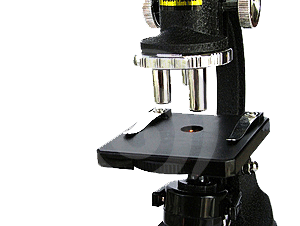Direct count
 So, Frank's got about 5 liters of blood, and he probably won't miss a few mLs all that much. Let's say we took that 10 mL, centrifuged out the gigantic stuff like red blood cells, put the rest on a slide under a microscope, and counted every thing that looked like a meningicoccus. That's certainly one way of quantifying the population. We'll call it ... Direct Count. Pretty easy, conceptually speaking, although it takes a bit of time to do the centrifuging and to make the slide, and even more time to actually count. But, that's what underpaid lab interns are for, right?
So, Frank's got about 5 liters of blood, and he probably won't miss a few mLs all that much. Let's say we took that 10 mL, centrifuged out the gigantic stuff like red blood cells, put the rest on a slide under a microscope, and counted every thing that looked like a meningicoccus. That's certainly one way of quantifying the population. We'll call it ... Direct Count. Pretty easy, conceptually speaking, although it takes a bit of time to do the centrifuging and to make the slide, and even more time to actually count. But, that's what underpaid lab interns are for, right?
OK, so you've counted using a Petroff Hausser chamber under the light microscope and found that you have 326 meningicocci in 10mL of blood. What does that mean?
A less experienced lab intern might run off to tell the doctor that Frank has a total population of 326 meningicocci living in him. Not you, however, because you remember that you only sampled 10 mLs of Frank's blood.
What you need to know is what fraction of Frank's blood you sampled:
10mL/5000mL = 1/500th
So, in Frank as a whole, you would expect to find about 500 times as much as you did in your sample.
500 * 326 = 163,000 meningicocci
This scaling up method (sometimes called multiplying by the inverse) is absoluately critical for successfully calculating the actual population from a sample. If you feel at all iffy about this, try some practice problems here:
Copyright University of Maryland, 2007
You may link to this site for educational purposes.
Please do not copy without permission
requests/questions/feedback email: mathbench@umd.edu